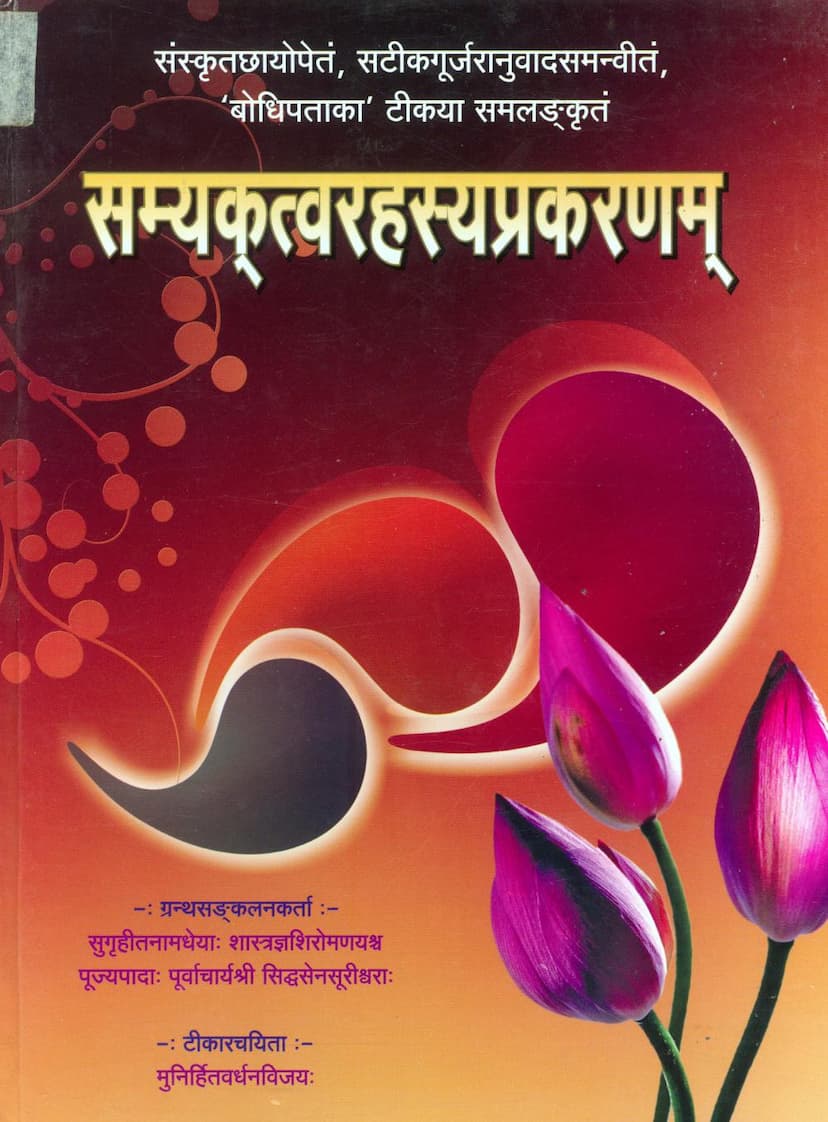Samyaktva Rahasya Prakaranam
Added to library: September 2, 2025

Summary
Summary of "Samyaktva Rahasya Prakaranam" with "Bodhipataka" Commentary
This document presents the Jain text "Samyaktva Rahasya Prakaranam," compiled by the revered ancient Acharya Siddhasenasuri, with a comprehensive commentary titled "Bodhipataka" composed by Muni Hitvardhanvijay. The work, published by Kusum Amrut Trust, delves deeply into the nature, characteristics, faults, variations, glories, and benefits of Samyaktva (Right Faith or Right Belief) in Jainism.
Key Aspects of the Text:
- Original Text: "Samyaktva Rahasya Prakaranam" is a 66-verse work in Prakrit, focusing on the definition, practices, transgressions, greatness, and fruits of Samyaktva. The exact period of Siddhasenasuri's life is uncertain due to a lack of definitive evidence.
- Commentary (Bodhipataka): Muni Hitvardhanvijay has authored the "Bodhipataka" commentary in Sanskrit prose. This commentary is exceptionally comprehensive, comprising over 820 verses (ślokas).
- Scholarly Approach: The commentary is noted for its depth, referencing over 132 scriptural proofs from both Shvetambara and Digambara traditions, and even drawing parallels with Hindu scriptures like the Manusmriti. This broad citation demonstrates a thorough and inclusive approach to explaining Samyaktva.
- Significance of Samyaktva: The text emphasizes Samyaktva as the primary component of the "three jewels" (Ratnatrayi) and refers to it as a "Bhavatirtha" (spiritual pilgrimage). It is considered the foundation for right knowledge (Samyagjnana) and right conduct (Samyagcharitra). The text highlights that without Samyaktva, other spiritual practices are futile, like a ship without sails or a tree without roots.
- Detailed Exploration: The commentary meticulously explains the concept of Samyaktva, differentiating it from Mithyatva (wrong faith). It categorizes Samyaktva into various types based on different classifications (e.g., one, two, three, four, five, and ten types), including Nisarga-ruchi, Upadesha-ruchi, Dravya-Samyaktva, Bhava-Samyaktva, Oupashamika, Kshayopashamika, and Kshayika Samyaktva.
- Elimination of Faults: The text details various faults that can afflict Samyaktva (Aticharas) and the importance of avoiding them, such as doubt (Samsaya), desire (Kanksha), and disbelief (Vichikitsa). It also elaborates on different types of Mithyatva to underscore the importance of its rejection.
- Illustrative Examples: Numerous analogies and examples are used to illustrate complex philosophical points, making the teachings accessible. The text emphasizes that even if one cannot fully adhere to strict conduct (Samyama), the adherence to Samyaktva is paramount.
- Historical Context: The commentary, composed in 2010 CE (Vikram Samvat 2066, Veer Samvat 2536), is the first known commentary on the original text, making it a significant contribution to Jain literature. The manuscript was meticulously researched and presented for the first time.
- Guidance for Spiritual Growth: The text guides the reader on the path to spiritual liberation by emphasizing the foundational role of Samyaktva and the necessity of its protection and cultivation throughout one's life.
In essence, "Samyaktva Rahasya Prakaranam" with the "Bodhipataka" commentary serves as an in-depth treatise on the pivotal Jain principle of Right Faith. It meticulously dissects the concept, illustrating its profound importance and the dire consequences of its absence, while offering a clear path for its attainment and preservation.